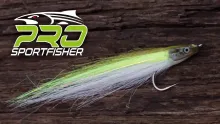In this streamer swap we are dealing with the 17 patterns designed by Lew Oatman, avid fly fisher and professional tyer from Shushan, New York.

When we tie on a nymph, emerger or dry fly it is obvious to us that we are attempting to closely imitate a natural, native insect. This is done with the intent of enticing a fish via its "hunger motive". The same, however, cannot always be said of streamers. When we select a streamer or bucktail, we may not only get strikes of hunger, (as opposed to a hunger strike!) but also ones of anger, curiosity or playfulness. It is thought that the latter three strike motives are more often aroused by "attractor" type streamers - those designed using unnatural colors, shapes and/or proportions. This is because they are usually not representative of anything the fish has eaten or seen in the water.
In this streamer swap we are dealing with the 17 patterns designed by Lew Oatman, avid fly fisher and professional tyer from Shushan, New York. Shushan is a small town that lies along the NY/VT border where the lower Battenkill River flows. Mr. Oatman, who died in 1958, was a pioneer of "exact imitations" - streamers that closely resemble native forage fish, and therefore play to a fish's hunger and natural feeding instincts. This factor gives them added value to the fly fisher over an "attractor", in that a fish may strike more often out of hunger than for the other three reasons.
Lew Oatman's streamers, along with Keith Fulsher's exact immitation bucktails, Sam Slaymaker's trout fry patterns and Art Flick's Black Nosed Dace, were among the earliest of the "exact immitation" style. In a letter written to Joseph Bates, Mr. Oatman stated that he had developed these 17 patterns after discovering that, except for the smelt imitations of Maine, he could not find anything that would accurately imitate the various forage fish he had observed. He had also made the comment that many "imaginative patterns", using just about any variety of material, may take fish, but lack "sound reason" in their design. Lew felt that an exact immitation would be a more consistent producer over time, in most any fishing condition.
All 17 of Lew Oatman's patterns are shown on a single color plate in Joseph Bates' book "Streamer Fly Tying and Fishing". Looking at these streamers, one will notice that they bear some very distinct similarities -- streamlined profile, ribbing for flash, jungle cock eyes, light colored bodies and often simple, muted wing coloration. The Mad Tom would be the only glaring exception in this "set", as it is a general large black catfish fry immitation. Next to some of the more colorful, gaudier patterns available, many of these flies might seem underdressed or even a bit mundane at first (although the 'Brook Trout', with its little colored spots, is a real eye-catcher). Yet, it is this very quality that makes them so effective. These subtle details are what make them look just like what the bigger fish have been eating all along. In fact, these more naturally colored, simpler streamers often take more and bigger fish than do their ostentatious counterparts. This may be especially true of wary brown trout in clear water. And while these patterns are very under-utilized, it takes only a bit of experimentation on the part of the angler to begin to show the true value and significance of Mr. Oatman's contributions. His "sound reason" and inspiration for the remaining 16 patterns are as follows:
Battenkill Shiner: Shiners common to the Battenkill River.
Brook Trout: For use where large Brook trout will feed on small ones. Also effective for Rainbows and others.
Cut Lips: Cut Lips Minnow is native to the NY's Ausable, the Battenkill and many other trout streams. Oatman liked this in larger sizes.
Doctor Oatman: Named after Lew's father, a country doctor.
Ghost Shiner: Imitates the baitfish of the same name. Also similar to Straw-colored, Pearl and Emerald Minnow. Has consistently done well in difficult, clear-water conditions. Can be tied down to very small, sparse sizes.
Golden Darter: Spare pattern for Black Nosed Dace. Companion to the Silver Darter. The Golden often is superior in off-colored water and the Silver in clear.
Golden Shiner: One of the best for Largemouth Bass, where they feed on these shiners.
Golden Smelt: Developed in 1953 to imitate the smelt of the same name.
Gray Smelt: Designed to represent the gray/green and white/silver flash of the natural smelt. Tied slender, especially in larger sizes for Landlocked Salmon. Excellent trolling streamer.
Male Dace: Imitates male Black Nosed Dace in spawning season.
Red Fin: Originated in 1952. Simulates the colors of the Red Fin Shiner. Takes advantage of lateral stripe of badger saddle. At first, tail & throat were longer, but Oatman decided the pattern was more effective if they were clipped.
Red Horse: Designed for bass where they feed on the Red Horse Sucker.
Shushan Postmaster: Bucktail pattern originated in 1953. Named after Al Prindle, frequent Battenkill fishing companion of Oatman's, and the postmaster of Shushan, NY in the 30's and 40's.
Silver Darter: Imitates the Cayuga Minnow. Effective for all trout. Effective in heavily fished streams, as well as wilderness areas. Should be tied very slim.
Trout Perch: Used to entice Pike Perch, which feed heavily on schools of spawning Trout Perch Minnows.
Yellow Perch: Designed for Largemouth bass which feed on schools of small Perch. Also works for Rainbow Trout in lakes where they do the same. This streamer, along with the Golden Shiner, will prompt Bass strikes during the day, when they will not hit noisier lures.
Hand picked for this article
- Log in to post comments









